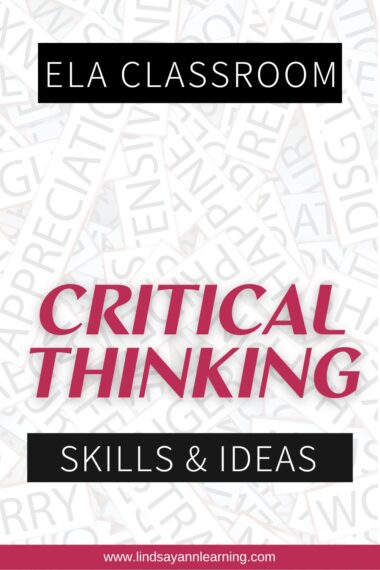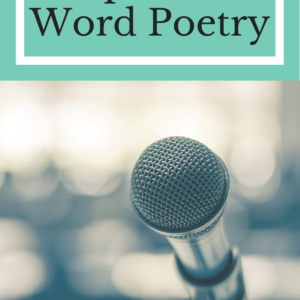Recently, I’ve been getting a lot of questions about teaching spoken word poetry, especially when it comes to teaching students to craft a slam poem that connects with the audience on a personal level and sounds professional and polished.
I’ve taught slam poetry to students for the last seven+ years and nothing brings me more joy than seeing students gain the confidence to express themselves through spoken word.
I created these videos originally for my own students. They are quick and actionable and filled with examples for students to see the strategies in action.
How to Use These Slam Poetry Writing Tutorials
➡ Use these videos to flip the classroom or during a writing stations activity. It is best if you pull students for a quick student-led conference to discuss their takeaways and/or revisions made as a result of viewing the video. Alternatively, I have students leave me a comment on their draft reflecting on what they learned and how they revised as a result. This way, I can take a look at their progress and leave feedback / tell them to re-watch a certain part of the video if they need further work/application.

➡ We all know that teacher feedback is best when it’s targeted and specific as well as timely.
Spoken word poetry is usually easy to breeze through and leave formative feedback for students, but the process is further simplified for me when I can leave a quick comment about what I’m noticing/what I like so far in a student’s draft and then link to the video that I think they need to watch for the “next step” in the revision process.
This way, I can keep a student moving along and also hold them accountable for viewing these mini lessons and applying when I conference with them or check in the next time on their writing progress.
➡ Pop these videos into a recursive Google Form and let students pace themselves through the videos depending on their needs.
Picking a Spoken Word Poem Topic
When it comes to writing spoken word poetry, it’s important for students to explore a variety of different poets and examples of spoken word poetry. There are so many different styles that a student is sure to find a slam poet they can connect with because of the content of the poetry and/or the performance style.
➡️ The number one question I hear from teachers is focused on how to get students to engage and pick a topic for their slam poems.
In response, I want to say that it’s our job as teachers to open up the world of spoken word poetry in a way that doesn’t intimidate students, but rather invites them to explore and add their own voices into the mix.

I always start by debunking misconceptions about spoken word poems as students tend to think they have to be angry rants that are melodramatic and “over the top.”
Not so. When students see writing a slam poem can be as simple as telling a story or sending a message, they can let down their guard and start to connect.
Furthermore, when students see slam as an extension of who they are, they become invested in making it represent what they really care about and are invested in.
When it comes to picking a poem topic, students tend to go wide rather than deep. They think that having a topic = having a poem. Not so. A topic can turn into any number of different poems, depending on the angle a student chooses.
➡️ So, my number one tip for choosing a spoken word topic is to brainstorm a lot. Start students out with writing lists like Sarah Kay suggests. Conference with them, have them listen to a lot of slam poems, and it will come.
➡️ Second, I suggest showing students who are still struggling to get started this video on narrowing a topic and avoiding the two biggest slam poetry “killers”: melodrama and generic writing.
How to Write Spoken Word Poetry
Next, when students are drafting their slam poems, follow-up with these four mini-lessons.
➡️ The first lesson helps students to see how “show don’t tell” applies to their writing. Students will work to develop their writing with specific, concrete details and use of imagery.
➡️ The second lesson is for students who have a solid draft and are ready to fine-tune at the sound level. Using consonance, assonance, and alliteration is a way for students to make their poems sound cohesive, but it’s really important for students to consider the overall tone they’re going for and to choose soft or hard sounding word sounds to echo. This strategy is what creates a tone on a subtle sound-level, and it can also help students to achieve a really dramatic tone shift.
➡️ The third lesson is probably my favorite because I can always see the lightbulb moments for students who think that rhyme always has to be predictable, perfect end rhyme. See for yourself what other strategies you can make available to students and watch their slam poems transform from geek to fleek.
➡️ The final lesson I’ll share here is for final editing. Students need a little nudge to think about line divisions and omission of “fluff” words from their writing. For example, a lot of the time students can omit articles from their writing to achieve a cleaner and more poetic sound to their lines. Oh, and at the end of the video I model and “think aloud” as I edit a slam poem draft.
More Slam Poetry Teaching Resources
I would be remiss if I didn’t tell you about my FREE slam poetry guide for teachers. I’d love to share more ideas with you, so be sure to download it HERE if you haven’t already.















 Teaching Voice in Writing Made Simple
Teaching Voice in Writing Made Simple

This is really helpful, thanks lots Lindsay Ann and Guante.
You’re welcome! 🙂
I love your site,and it has been extremely helpful to me. My question regarding the slam poetry regards how much time I need to do a mini- unit on this? I am at a private school and the curriculum is somewhat set, but I think this would be so valuable.
So glad to hear from you, Anna!
You could easily fit a mini slam poetry exploration in-between units (or to expand on themes you’re studying in other texts) or bring in slam poems as paired or mentor texts for written response. I guess it depends on how “official” you want to make the mini-unit. For students to write their own slam poems, I’d say you’d probably want to spend at least a week exploring the genre before having students write and share their own work formally or informally.
I hope this helps!
Lindsay